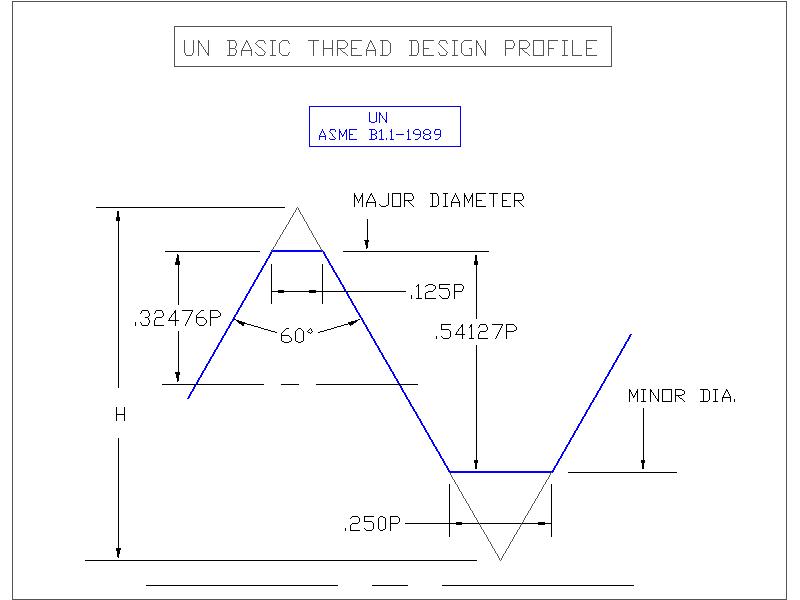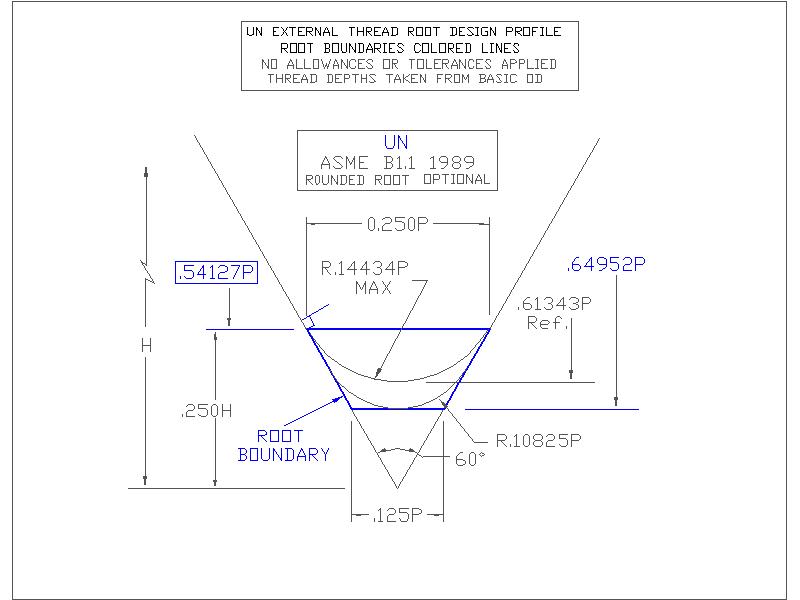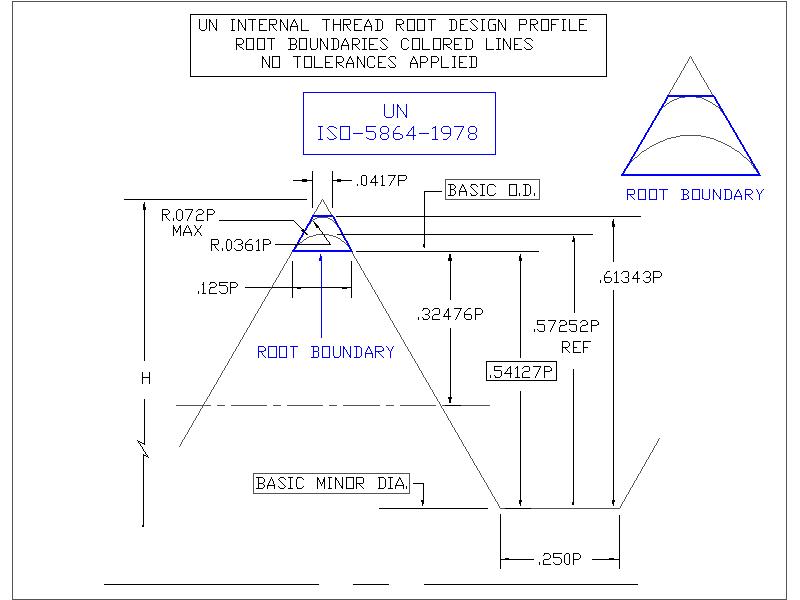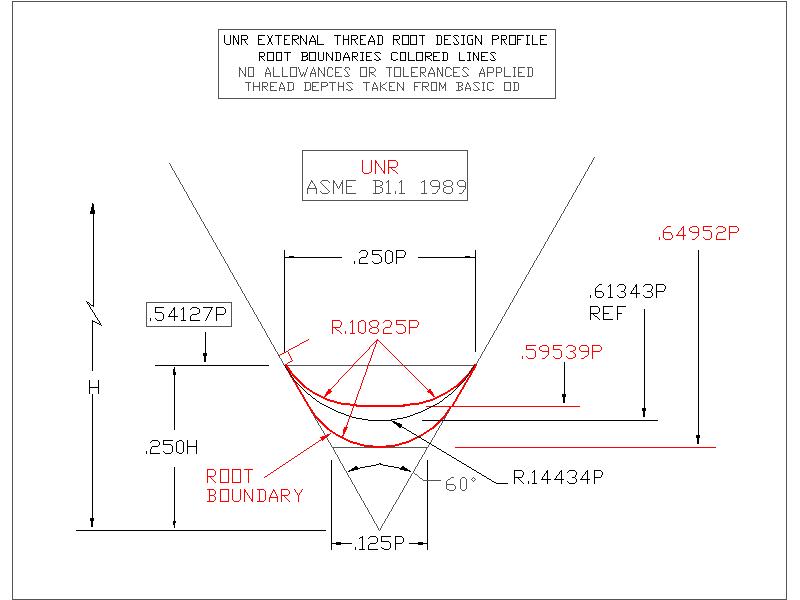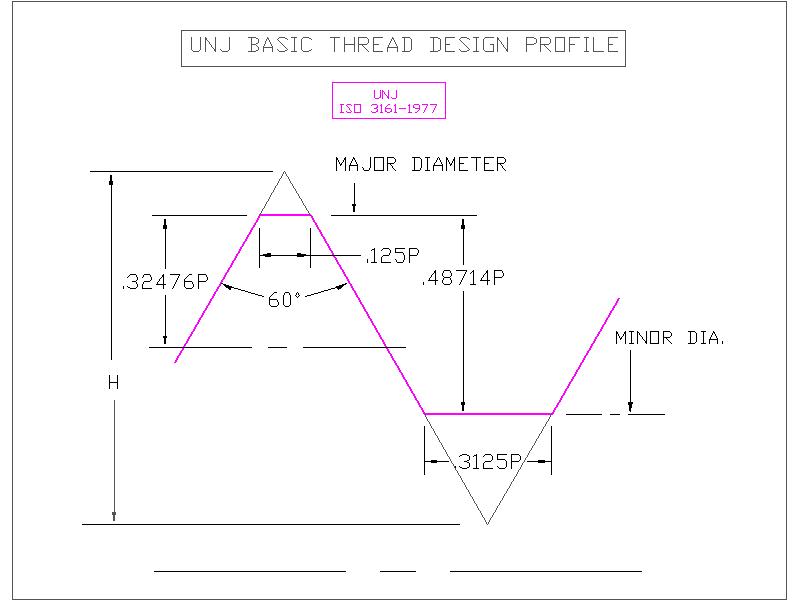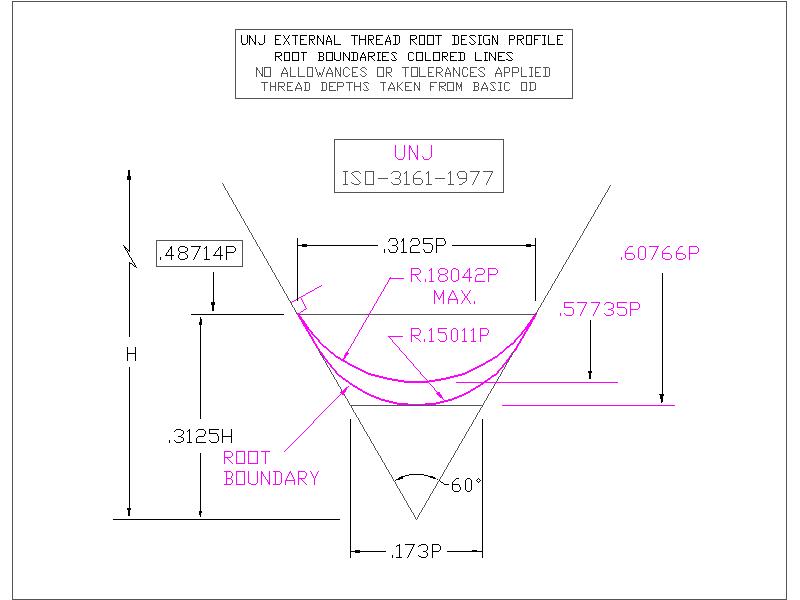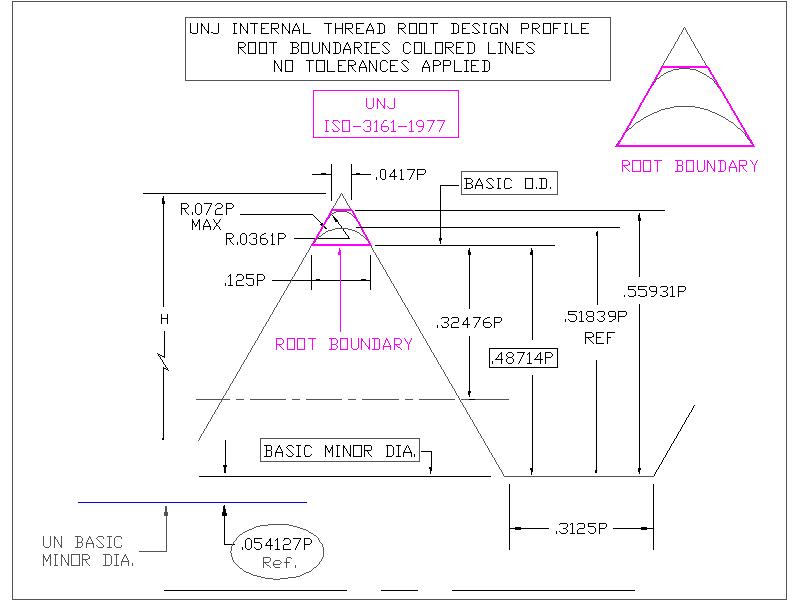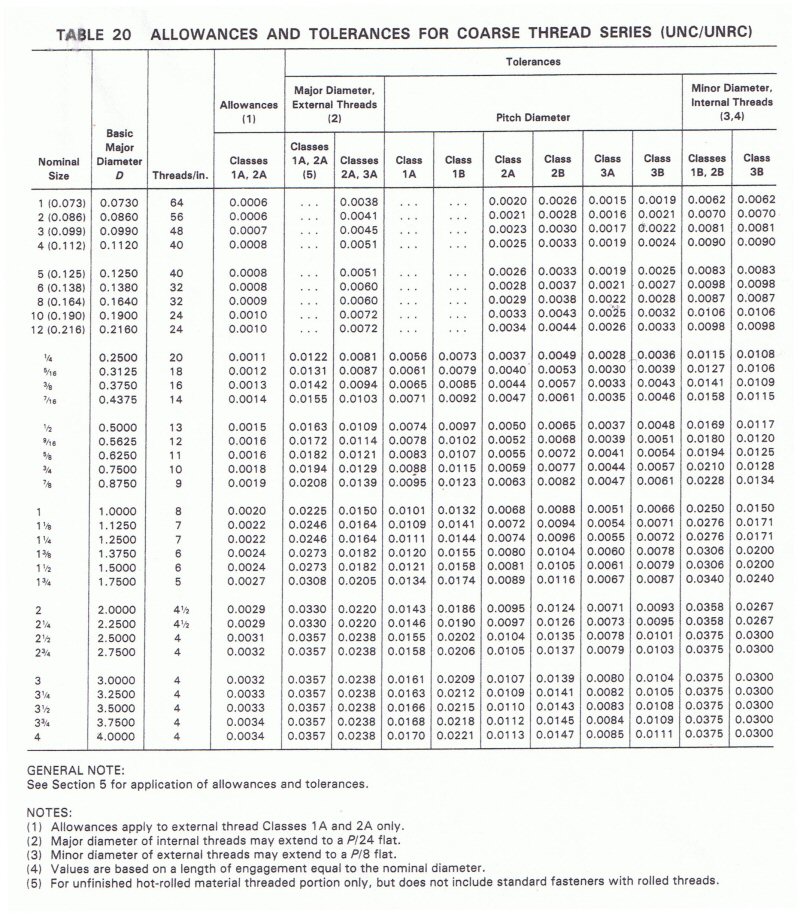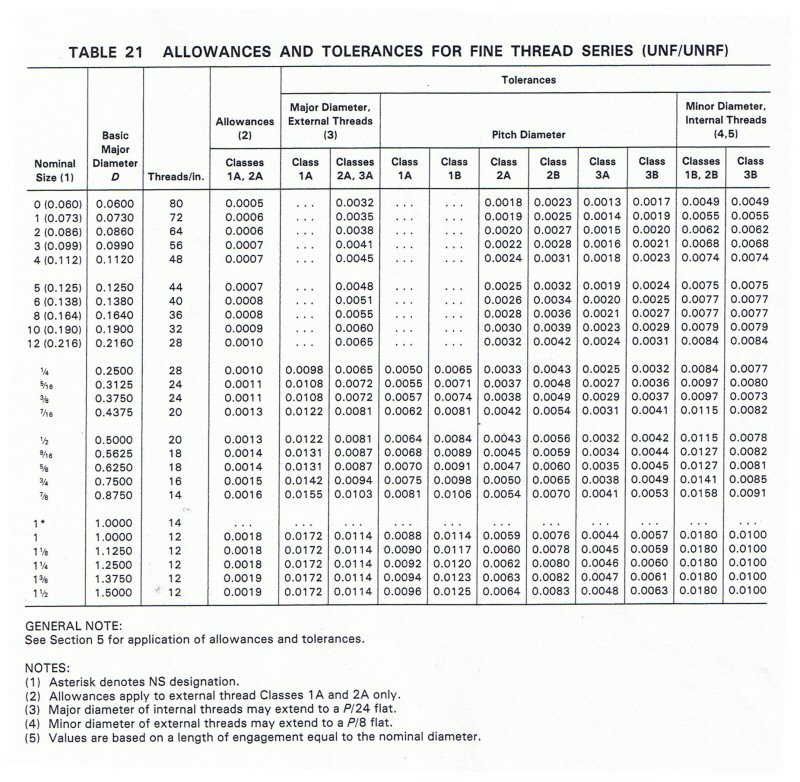|
Colin Nairn Oct. 2010 colinnairn@gmail.com (Comments/Suggestions) |
REFERENCES |
ABBREVIATIONS
This paper was compiled to get a clearer understanding of UN, UNR &
Summary of Contents
--
The section "General Notes" contains some miscellaneous observations.
Using the "Easy Memory Chart" (see the drawings to clarify), I can accurately cut a UN class 3 external thread and know that is correct and will fit without having to use a gage or any tables. I would just stay away from MMC on all 3 diameters. For a class 1 or 2 external, however, I also need to know the allowance, which is available in Machinery's Handbook.
1.) The Best D.O.T. was chosen so that no matter what T.N.R. is used
BEST INTERNAL THREAD DEPTHS (from UN basic minor dia.)
UN BASIC MINOR DIA. = basic O.D. - (2 X .54127P).
MOW Formulas
AN= American National
BWS= Best Wire Size
ASME= American Society of Mechanical Engineers
DIA= Diameter
DOT= Depth of thread
H= height
ISO= International Standards Organization
MAX= maximum
MIN= minimum
M/C H/B= Machinerys Handbook
MMC= Maximum material condition
MOW= Measurement Over Wires
OD= Outside Diameter
P= Pitch = 1/TPI
PD= Pitch Diameter
R= Radius
REF= Reference
TDS=Tap Drill
TNR= Tool Nose Radius
TPI= Threads Per Inch= 1/P
UN= Unified National
UNC= Unified National Coarse
UNF= Unified National Fine
~ Approximately equal to
.
UNJ threads. The data was taken from ASME & ISO standards and
transposed from the function H, the height of the thread triangle, to "P", a
function of the pitch, so the machinist can control the 3 diameters, major
minor & pitch.
The other reason is to get a look at the root dimeter profile because when cutting a thread the root diameter is important in that it determines the strength of the thread. When cutting a thread, plunging the cutter deeper to get to size reduces the root diameter.
The section "A Practical Method to cut a Thread" is included so that even a novice could cut an accurate thread.
The following Easy Memory Chart is a summary of all the data with the following
two points in mind
(within limits) the thread profile will be correct.
2.) The D.O.T. is given at MMC with no tolerances or allowances
applied. Therefore, in a pinch you could cut the thread with the
information given and guesstimate or look up, the tolerances
and allowance for the amount to move the three diameters away from
MMC.
EASY MEMORY CHART
(NO TABLES-MMC)
BEST EXTERNAL THREAD DEPTHS (from basic O.D.)
UN .61343P (R 0 to .14434P)
UNR .61343P (R .10825P to R .14434P)
UNJ .57735P (R .15011P to R .18042P)
(Don't confuse .10825 with .18042)
UN/UNR/UNJ = .57252P (R 0 to .072P)
then for a UNJ increase the minor diameter by (.054127P X 2).
BASIC P.D. = Basic O.D. - .64952P (UN,UNR,UNJ,External & Internal).
Max. D.O.T. is D.O.T. selected plus 1/2 the allowance plus 1/2 the P.D. tolerance.
BWS = .57735P
MOW = Nominal O.D. - (1.5155P) + 3W (W = actual wire size used).
MOW = Pitch Diameter - (.86603P) + 3W (W = actual wire size used).
No allowance
or tolerances
applied.
HOME
A PRACTICAL METHOD TO CUT A UN THREAD
|
1) Using the "Easy Memory Chart" calculate the following--Pitch Diameter, Depth of Thread, Best Wire Size, Measurement Over Wires and the UN basic minor diameter (if you are cutting an internal thread). Be sure to use the actual wire size used, not the best wire size, in the Measurement Over Wires formula.. For example- 1-8-UNC-3A, O.D.=1.00, PD (max.) = .9188, DOT = .0767, BWS = .072, MOW = 1.0266 1-8-UNC-3B, Basic minor dia. = .8647, DOT = .0716, 2) Machine the reference diameter, O.D. for external, I.D. for internal. Do not chamfer the leading edge, this will allow the cutter to take the initial shock on the flank as opposed to the tool tip. 3) (Important) Make sure that the threading tool has no rake, the profile is correct, it is on center and perpendicular to the work. (Use a sharp pointed cutter with a small radius honed on the point). 4) Set the lathe levers or change gears for the desired pitch or T.P.I. Then take a light cut to check it is correct and set the crosslide dial to zero. 5) To cut an internal thread first cut an external thread, to MMC, to use as a gage. Then machine the internal minor diameter (basic) as a reference for the depth of cut. 6) Set the compound parallel to the lathe axis, then feed the cutter in using the crosslide and the compound, whatever you feed in on the crosslide, feed ½ of that on the compoundfor example, if you feed .012 radially (.024 dia.) on the crosslide, feed .006 on the compound. This means that most of the chip will be coming off the leading edge of the cutter preventing the chip from piling up in the middle, it is similar to feeding the cutter in at 29 1/2 degrees . When you reach the proper depth you can now move the compound back and forth to get the pitch diameter without changing the minor diameter.
7) An easy way to use the three wire method to measure the pitch diameter--
|
|
GENERAL NOTES
Flanks of all UN, UNR, UNJ external threads to be straight above the basic minor diameter (as shown by the perpendicular sign in the drawings), for internal threads it is below the basic major diameter. (Therefore, if cutting a UN external flat root at MMC the tool must be sharp, absolutely no radius).
PD (basic) is the same for UN, UNR, UNJ, external, internal.
Allowance is always applied to external.
No allowance on a class 3 or UNJ or internal. Therefore a bolt/nut cut to MMC will be
There is no UNR internal.
A UNJ bolt will only mesh with a UNJ nut.
UNJ is always class 3
The min. root radius of a UNJ external is greater than the max. radius of a UN, UNR.
A UNJ internal thread profile is the same as a UN except the basic minor dia. is increased
Threads are only rolled up to 1 diameter after which they are cut. (Rolled is stronger).
A bolt is loaded in tension, a nut is loaded in compression.
UNK- same as UNR except the minor diameter of the external thread is toleranced and
Do not exceed 83% AN TDS, (100% UN).
There is no class 1 for sizes below Ό ".
P.D. tolerance internal is greater than the P.D. tolerance external. (By 30%, ASME B1.1- 1974).
UN bolts- tensile strength 60,000 psi.
Length of engagement |
DEFINITIONS
UN
EXTERNAL
D.O.T.
(From basic O.D.)
Max. = .64952P + ½ allowance + ½ PD tolerance.
Min. = .54127P (no radius) + ½ allowance.
Best DOT = .61343P + ½ allowance + ½ PD tolerance used.
ROOT RADIUS
Optional but not to exceed .14434P (@ .61343P D.O.T.).
O.D.
Max. = Nominal allowance.
Min. = Nominal allowance tolerance.
O.D. Tolerance
Class 1 = .09 x 3√P2
Class 2/3 = .06 x 3√P2
P.D.
Max. = nominal O.D.
.64952P
allowance.
Min. = PD Max. tolerance.
MINOR DIAMETER (Ref)
Max. = nominal O.D. (.54127P x 2) no radius allowance.
Min. = nominal O.D. (.64952P x 2) allowance PD tolerance.
UN INTERNAL
MINOR
DIA.
P.D. Min.= Basic, all
classes
Min.(Basic) = Nominal O.D.
(.54127P x 2) = O.D. .64952P
Max. = tables
Max.= Basic + PD tol.
for class specified
D.O.T. (From basic
minor diameter)
Min. = .54127P (Sharp tool, no radius)
Max. = .61343P + ½ the P.D. tolerance.
Best
= .57252P + ½ PD tolerance (allows for a radius of 0 to .072P).
ROOT RADIUS 0 - .072P
EXAMPLE
.250 - 20 - UNC- 2A (EXTERNAL)
D.O.T.
Max.= .0325 + .00055 + .00185 =
.0349
Min. = .0271 + .00055 = .0276
Best = .0307 + .00055 + .00185 = .033
ROOT RADIUS
Max. = .0072
Min. = 0
O.D.
Max. = .250 .0011 = .2489
Min. = .250 .0011 .0081
= .2408
P.D.
Max. = .250 .03248 .0011 = .2164
Min. = .2164 .0037 = .2127
MINOR DIA.(Ref)
Max. = .250 .0541 .0011 = .1948
Min. = .250 .06495 .0011
.0037 = .1802
.250 - 20 - UNC- 2B (INTERNAL)
MINOR
DIA.
P.D.
Min. = .250 .05413 = .1959 Min = .250 .03248 = .2175
Max. = tables = .207 Max. = .2175 + .0049 = .2224
D.O.T.
Min. = .0271 (Sharp tool no radius)
Max. =.0307 + .0024 = .033
Best = .0286 + .0024 = .031
ROOT RADIUS
0 - .0036
